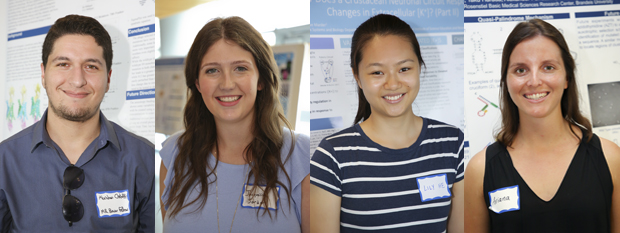SciFest VII highlights student research
The summer exposition of student research shows off the cutting-edge work done by undergraduates over the summer.
 Photo: Mike Lovett
Photo: Mike LovettFrom left to right: Abraham Cheloff, Jacqueline Jordan, Lily He and Ariana Traub.
Since it started in 2011, SciFest has become one of the Brandeis summer season’s highlights. This year’s event, on August 3, featured 105 students presenting the results of the research projects they completed typically working alongside a professor and graduate student or postdoctoral fellow. The poster sessions took up two floors of the Carl J. Shapiro Science Center and showcased the diversity and complexity of the research undergraduates do at the university.
Here’s a few highlights from the poster sessions:
Abraham Cheloff ’18
"Characterization of Monobody Interactions with EC2 Fluoride Ion Channel by Fluorescence Anisotropy"
Faculty Mentor: Professor of Biochemistry Christopher Miller
Funder: M. R. Bauer Foundation Summer Undergraduate Research Fellowship
Synthetically engineered designer proteins are one of the most promising and cutting-edge areas of medicine today. Already such proteins have been used to treat cancer and autoimmune disease therapies. They work similarly to the antibodies already in our cells, targeting with pinpoint precision the toxin responsible for the illness.
Cheloff took two designer proteins and exposed them to cellular structures in bacteria. He wanted to know why one of them sticks to its target with five times the strength as the other. To do so, he changed the genetic makeup of the protein with the weaker binding strength. Understanding this could enable us to fine-tune a protein drug’s "stickiness" so it stays connected to its target longer.
So far, the results show that the small genetic differences lead to differences in how each designer protein sticks to its target.
Jacqueline Jordan ’19
"Regulation of the abundance of Ddc2/ATRIP after DNA damage"
Faculty Mentors: Abraham and Etta Goodman Professor of Biology James Haber
Jordan looked at a protein called Ddc2 that plays a vital role in responding to DNA in yeast cells. Damage happens all the time, but when it’s not accurately repaired, the DNA alterations can become permanent. In humans, DNA errors can lead to diseases including cancer. Ddc2 has an analog in humans, the protein ATRIP.
Ddc2 is an essential component of what is called a DNA checkpoint, a cascade of events triggered by DNA damage that, if possible, gives cells enough time to carry out DNA repairs. Jordan’s findings show that the amount of Ddc2 rises and falls in response to DNA damage. This suggests that cells regulate the level of Ddc2 to fine-tune the functioning of the DNA checkpoint and thereby modulate their response to DNA damage.
Lily He ’19
"How Does a Crustacean Neuronal Circuit Respond to Changes in Extracellular [K+]? (Part II)"
Faculty Mentor: Victor and Gwendolyn Beinfield Professor of Neuroscience Eve Marder
Funder: M. R. Bauer Foundation Summer Undergraduate Research Fellowship
Lily He studied the nervous system of crabs, specifically the pyloric circuit, a group of neurons that drive the stomach muscles. Like our heart beat, the neurons in the pyloric circuit fire continuously. She wanted to know why and how the pyloric circuit maintains these steady firings as the crab’s environment changes.
She isolated stomach neurons and bathed them in a solution rich in potassium, which is ordinarily present in sea water. She then monitored the neuronal firing activity. Her findings show that the firing activity stops in high levels of potassium, but later returns to normal activity patterns.
Crabs’ nervous systems are similar to humans’. He’s research is a step toward understanding how our own brains react and adapt to the outside world to keep us going.
Ariana Traub ’18
"Acquisition and Location of Mutation Clusters in Escherichia coli"
Faculty Mentor: Abraham S. and Gertrude Burg Professor of Microbiology Susan Lovett
Funder: Dr. Frederick W. Alt ’71 Summer Biology Research Fellowship
Traub is working on a curious feature found in the genetic code of people with illnesses such as Duchenne muscular dystrophy and certain cancers — palindromes. These palindromes are similar to the linguistic kind. A verbal palindrome looks like this — Go dog. It spells the same thing forwards and backwards. A genetic palindrome involves the nucleic acids that make up DNA. An example looks like this — GGCC, which refers to the nucleic acids, guanine, guanine, cytosine and cytosine.
Sometimes, the palindromes aren’t perfect. An errant nucleic acid here and there throws off the palindromic effect. These are called quasi-palindromes and in humans, can give rise to mutations that lead to serious disease.
Traub is trying to better understand and locate these quasi-palindromes in bacteria. She’s tried several experimental methods, but so far her success has been limited. Next she will experiment with azidothymidine (AZT), the same compound used to treat HIV to force mutations in the hopes of isolating quasi-palindromes. She expects to have results in a few a months.
For a full list of funders and poster sessions, click here.
Categories: Research, Science and Technology





